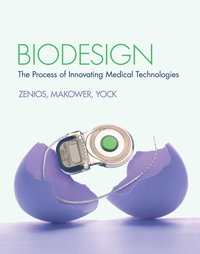October 5, 2009 - By Stephanie Pappas

Silicon Valley’s entrepreneurial culture has long been a boon for medical technology innovation at Stanford. Now, Stanford’s pioneering graduate student training program in medical device development is exporting some of that expertise with a new textbook.
The book, Biodesign: The Process of Innovating Medical Technologies, was released Oct. 1 from Cambridge University Press. Inside, readers can find 29 chapters, each describing a step in the process of innovation, from identifying medical needs to bringing products to market.
“For the first time, we’ve put all of our fundamental principles, case examples and the whole process of innovating into a textbook,” said Josh Makower, MD, consulting associate professor of medicine in the Stanford Biodesign Program and a senior editor of the textbook.
The book’s development stretches back almost to 2001, when Stanford Biodesign opened its doors. Each year, the program takes 80 graduate students from multiple disciplines and teaches them how to invent medical devices. Originally, the course materials consisted mainly of a syllabus and an outline, but that soon expanded into the biodesign sourcebook, a bound collection of papers. That’s when Paul Yock, MD, the Martha Meier Weiland professor in the School of Medicine and the program’s director, began to get requests.
“We started getting people, venture capitalists, coming to us and saying, ‘Could we get a copy of your sourcebook?’” Yock said. “It dawned on us that it might be a good idea to take the next step and make a textbook.”
More than 90 universities worldwide now offer biodesign courses, a number of which are modeled after Stanford’s program. The editors hope that their book, the first of its kind, will become the go-to text for those courses, as well as for medical technology companies. After all, Makower said, the book gets to the heart of the Stanford Biodesign credo: Innovation can be taught.
“Society has done itself a disservice,” said Makower, who is the CEO of ExploraMed, a medical device development company. “It’s made us believe that inventors are people with crazy hair, trapped away in their basements doing experiments and all of a sudden a eureka moment happens. What we teach at biodesign is that everyone is capable of being an inventor.”
The book breaks down the process of innovation into three I’s — identify, invent and implement — and illustrates the themes through more than 40 case studies of companies like Kyphon, which develops technology for minimally invasive spinal surgery, or Cordis Corp., which produces stents and other endovascular technology. Those themes range from intellectual property regulations to sales, marketing and funding strategies, said principal writer Lyn Denend, MBA, a research associate at the Graduate School of Business. Each chapter concludes with a “Getting Started” section with step-by-step instructions to help innovators put their knowledge into action. And the book’s companion Web site, ebiodesign.org, offers further assistance in the form of links to databases, references and other online resources.
Yock and associate professor of business Stefanos Zenios, PhD, are the other senior editors of the book. The proceeds from the book’s sale will help fund the Biodesign Program. _____________________________________________________________________________
Stephanie Pappas is a former science-writing intern in the Office of Communication & Public Affairs.
About Stanford Medicine
Stanford Medicine is an integrated academic health system comprising the Stanford School of Medicine and adult and pediatric health care delivery systems. Together, they harness the full potential of biomedicine through collaborative research, education and clinical care for patients. For more information, please visit med.stanford.edu.